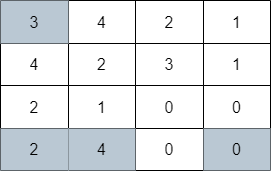Description
You are given a 0-indexed m x n integer matrix grid. Your initial position is at the top-left cell (0, 0).
Starting from the cell (i, j), you can move to one of the following cells:
- Cells
(i, k)withj < k <= grid[i][j] + j(rightward movement), or - Cells
(k, j)withi < k <= grid[i][j] + i(downward movement).
Return the minimum number of cells you need to visit to reach the bottom-right cell (m - 1, n - 1). If there is no valid path, return -1.
Example 1:

Input: grid = [[3,4,2,1],[4,2,3,1],[2,1,0,0],[2,4,0,0]] Output: 4 Explanation: The image above shows one of the paths that visits exactly 4 cells.
Example 2:

Input: grid = [[3,4,2,1],[4,2,1,1],[2,1,1,0],[3,4,1,0]] Output: 3 Explanation: The image above shows one of the paths that visits exactly 3 cells.
Example 3:

Input: grid = [[2,1,0],[1,0,0]] Output: -1 Explanation: It can be proven that no path exists.
Constraints:
m == grid.lengthn == grid[i].length1 <= m, n <= 1051 <= m * n <= 1050 <= grid[i][j] < m * ngrid[m - 1][n - 1] == 0
Solution
Python3
from sortedcontainers import SortedList
class Solution:
def minimumVisitedCells(self, grid: List[List[int]]) -> int:
rows, cols = len(grid), len(grid[0])
R = [SortedList(range(cols)) for _ in range(rows)]
C = [SortedList(range(rows)) for _ in range(cols)]
pq = [(1, 0, 0)]
while pq:
d, r, c = heappop(pq)
if (r, c) == (rows - 1, cols - 1):
return d
index = R[r].bisect_left(c + 1)
while index < len(R[r]) and R[r][index] <= grid[r][c] + c:
nr, nc = r, R[r][index]
heappush(pq, (d + 1, nr, nc))
R[nr].remove(nc)
C[nc].remove(nr)
index = C[c].bisect_left(r + 1)
while index < len(C[c]) and C[c][index] <= grid[r][c] + r:
nr, nc = C[c][index], c
heappush(pq, (d + 1, nr, nc))
R[nr].remove(nc)
C[nc].remove(nr)
return -1